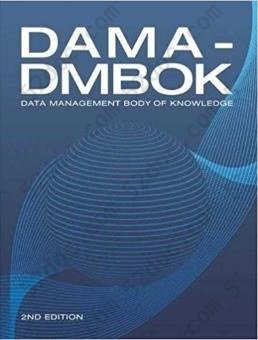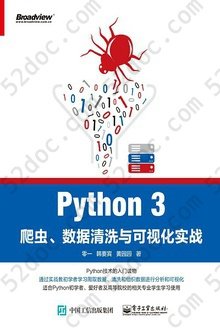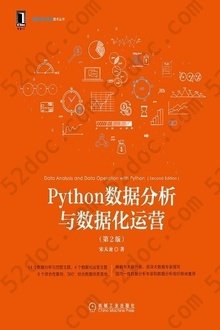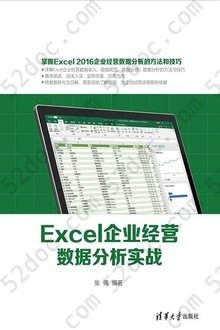注重体验与质量的电子书资源下载网站
分类于: 设计 计算机基础
简介

DAMA-DMBOK: Data Management Body of Knowledge (2nd Edition) 豆 0.0分
资源最后更新于 2020-10-05 18:39:51
作者:Dama International
出版社:Technics Publications
出版日期:2017-01
ISBN:9781634622349
文件格式: pdf
简介· · · · · ·
The Data Management Body of Knowledge (DAMA-DMBOK2) presents a comprehensive view of the challenges, complexities, and value of effective data management.
Today's organizations recognize that managing data is central to their success. They recognize data has value and they want to leverage that value. As our ability and desire to create and exploit data has increased, so too ha...
目录
Table of Contents
Preface
CHAPTER 1 Data Management
1. Introduction
1.1 Business Drivers
1.2 Goals
2. Essential Concepts
2.1 Data
2.2 Data and Information
2.3 Data as an Organizational Asset
2.4 Data Management Principles
2.5 Data Management Challenges
2.6 Data Management Strategy
3. Data Management Frameworks
3.1 Strategic Alignment Model
3.2 The Amsterdam Information Model
3.3 The DAMA-DMBOK Framework
3.4 DMBOK Pyramid (Aiken)
3.5 DAMA Data Management Framework Evolved
4. DAMA and the DMBOK
5. Works Cited / Recommended
CHAPTER 2 Data Handling Ethics
1. Introduction
2. Business Drivers
3. Essential Concepts
3.1 Ethical Principles for Data
3.2 Principles Behind Data Privacy Law
3.3 Online Data in an Ethical Context
3.4 Risks of Unethical Data Handling Practices
3.5 Establishing an Ethical Data Culture
3.6 Data Ethics and Governance
4. Works Cited / Recommended
CHAPTER 3 Data Governance
1. Introduction
1.1 Business Drivers
1.2 Goals and Principles
1.3 Essential Concepts
2. Activities
2.1 Define Data Governance for the Organization
2.2 Perform Readiness Assessment
2.3 Perform Discovery and Business Alignment
2.4 Develop Organizational Touch Points
2.5 Develop Data Governance Strategy
2.6 Define the DG Operating Framework
2.7 Develop Goals, Principles, and Policies
2.8 Underwrite Data Management Projects
2.9 Engage Change Management
2.10 Engage in Issue Management
2.11 Assess Regulatory Compliance Requirements
2.12 Implement Data Governance
2.13 Sponsor Data Standards and Procedures
2.14 Develop a Business Glossary
2.15 Coordinate with Architecture Groups
2.16 Sponsor Data Asset Valuation
2.17 Embed Data Governance
3. Tools and Techniques
3.1 Online Presence / Websites
3.2 Business Glossary
3.3 Workflow Tools
3.4 Document Management Tools
3.5 Data Governance Scorecards
4. Implementation Guidelines
4.1 Organization and Culture
4.2 Adjustment and Communication
5. Metrics
6. Works Cited / Recommended
CHAPTER 4 Data Architecture
1. Introduction
1.1 Business Drivers
1.2 Data Architecture Outcomes and Practices
1.3 Essential Concepts
2. Activities
2.1 Establish Data Architecture Practice
2.2 Integrate with Enterprise Architecture
3. Tools
3.1 Data Modeling Tools
3.2 Asset Management Software
3.3 Graphical Design Applications
4. Techniques
4.1 Lifecycle Projections
4.2 Diagramming Clarity
5. Implementation Guidelines
5.1 Readiness Assessment / Risk Assessment
5.2 Organization and Cultural Change
6. Data Architecture Governance
6.1 Metrics
7. Works Cited / Recommended
CHAPTER 5 Data Modeling and Design
1. Introduction
1.1 Business Drivers
1.2 Goals and Principles
1.3 Essential Concepts
2. Activities
2.1 Plan for Data Modeling
2.2 Build the Data Model
2.3 Review the Data Models
2.4 Maintain the Data Models
3. Tools
3.1 Data Modeling Tools
3.2 Lineage Tools
3.3 Data Profiling Tools
3.4 Metadata Repositories
3.5 Data Model Patterns
3.6 Industry Data Models
4. Best Practices
4.1 Best Practices in Naming Conventions
4.2 Best Practices in Database Design
5. Data Model Governance
5.1 Data Model and Design Quality Management
5.2 Data Modeling Metrics
6. Works Cited / Recommended
CHAPTER 6 Data Storage and Operations
1. Introduction
1.1 Business Drivers
1.2 Goals and Principles
1.3 Essential Concepts
2. Activities
2.1 Manage Database Technology
2.2 Manage Databases
3. Tools
3.1 Data Modeling Tools
3.2 Database Monitoring Tools
3.3 Database Management Tools
3.4 Developer Support Tools
4. Techniques
4.1 Test in Lower Environments
4.2 Physical Naming Standards
4.3 Script Usage for All Changes
5. Implementation Guidelines
5.1 Readiness Assessment / Risk Assessment
5.2 Organization and Cultural Change
6. Data Storage and Operations Governance
6.1 Metrics
6.2 Information Asset Tracking
6.3 Data Audits and Data Validation
7. Works Cited / Recommended
CHAPTER 7 Data Security
1. Introduction
1.1 Business Drivers
1.2 Goals and Principles
1.3 Essential Concepts
2. Activities
2.1 Identify Data Security Requirements
2.2 Define Data Security Policy
2.3 Define Data Security Standards
3. Tools
3.1 Anti-Virus Software / Security Software
3.2 HTTPS
3.3 Identity Management Technology
3.4 Intrusion Detection and Prevention Software
3.5 Firewalls (Prevention)
3.6 Metadata Tracking
3.7 Data Masking/Encryption
4. Techniques
4.1 CRUD Matrix Usage
4.2 Immediate Security Patch Deployment
4.3 Data Security Attributes in Metadata
4.4 Metrics
4.5 Security Needs in Project Requirements
4.6 Efficient Search of Encrypted Data
4.7 Document Sanitization
5. Implementation Guidelines
5.1 Readiness Assessment / Risk Assessment
5.2 Organization and Cultural Change
5.3 Visibility into User Data Entitlement
5.4 Data Security in an Outsourced World
5.5 Data Security in Cloud Environments
6. Data Security Governance
6.1 Data Security and Enterprise Architecture
7. Works Cited / Recommended
CHAPTER 8 Data Integration and Interoperability
1. Introduction
1.1 Business Drivers
1.2 Goals and Principles
1.3 Essential Concepts
2. Data Integration Activities
2.1 Plan and Analyze
2.2 Design Data Integration Solutions
2.3 Develop Data Integration Solutions
2.4 Implement and Monitor
3. Tools
3.1 Data Transformation Engine/ETL Tool
3.2 Data Virtualization Server
3.3 Enterprise Service Bus
3.4 Business Rules Engine
3.5 Data and Process Modeling Tools
3.6 Data Profiling Tool
3.7 Metadata Repository
4. Techniques
5. Implementation Guidelines
5.1 Readiness Assessment / Risk Assessment
5.2 Organization and Cultural Change
6. DII Governance
6.1 Data Sharing Agreements
6.2 DII and Data Lineage
6.3 Data Integration Metrics
7. Works Cited / Recommended
CHAPTER 9 Document and Content Management
1. Introduction
1.1 Business Drivers
1.2 Goals and Principles
1.3 Essential Concepts
2. Activities
2.1 Plan for Lifecycle Management
2.2 Manage the Lifecycle
2.3 Publish and Deliver Content
3. Tools
3.1 Enterprise Content Management Systems
3.2 Collaboration Tools
3.3 Controlled Vocabulary and Metadata Tools
3.4 Standard Markup and Exchange Formats
3.5 E-discovery Technology
4. Techniques
4.1 Litigation Response Playbook
4.2 Litigation Response Data Map
5. Implementation Guidelines
5.1 Readiness Assessment / Risk Assessment
5.2 Organization and Cultural Change
6. Documents and Content Governance
6.1 Information Governance Frameworks
6.2 Proliferation of Information
6.3 Govern for Quality Content
6.4 Metrics
7. Works Cited / Recommended
CHAPTER 10 Reference and Master Data
1. Introduction
1.1 Business Drivers
1.2 Goals and Principles
1.3 Essential Concepts
2. Activities
2.1 MDM Activities
2.2 Reference Data Activities
3. Tools and Techniques
4. Implementation Guidelines
4.1 Adhere to Master Data Architecture
4.2 Monitor Data Movement
4.3 Manage Reference Data Change
4.4 Data Sharing Agreements
5. Organization and Cultural Change
6. Reference and Master Data Governance
6.1 Metrics
7. Works Cited / Recommended
CHAPTER 11 Data Warehousing and Business Intelligence
1. Introduction
1.1 Business Drivers
1.2 Goals and Principles
1.3 Essential Concepts
2. Activities
2.1 Understand Requirements
2.2 Define and Maintain the DW/BI Architecture
2.3 Develop the Data Warehouse and Data Marts
2.4 Populate the Data Warehouse
2.5 Implement the Business Intelligence Portfolio
2.6 Maintain Data Products
3. Tools
3.1 Metadata Repository
3.2 Data Integration Tools
3.3 Business Intelligence Tools Types
4. Techniques
4.1 Prototypes to Drive Requirements
4.2 Self-Service BI
4.3 Audit Data that can be Queried
5. Implementation Guidelines
5.1 Readiness Assessment / Risk Assessment
5.2 Release Roadmap
5.3 Configuration Management
5.4 Organization and Cultural Change
6. DW/BI Governance
6.1 Enabling Business Acceptance
6.2 Customer / User Satisfaction
6.3 Service Level Agreements
6.4 Reporting Strategy
6.5 Metrics
7. Works Cited / Recommended
CHAPTER 12 Metadata Management
1. Introduction
1.1 Business Drivers
1.2 Goals and Principles
1.3 Essential Concepts
2. Activities
2.1 Define Metadata Strategy
2.2 Understand Metadata Requirements
2.3 Define Metadata Architecture
2.4 Create and Maintain Metadata
2.5 Query, Report, and Analyze Metadata
3. Tools
3.1 Metadata Repository Management Tools
4. Techniques
4.1 Data Lineage and Impact Analysis
4.2 Metadata for Big Data Ingest
5. Implementation Guidelines
5.1 Readiness Assessment / Risk Assessment
5.2 Organizational and Cultural Change
6. Metadata Governance
6.1 Process Controls
6.2 Documentation of Metadata Solutions
6.3 Metadata Standards and Guidelines
6.4 Metrics
7. Works Cited / Recommended
CHAPTER 13 Data Quality
1. Introduction
1.1 Business Drivers
1.2 Goals and Principles
1.3 Essential Concepts
2. Activities
2.1 Define High Quality Data
2.2 Define a Data Quality Strategy
2.3 Identify Critical Data and Business Rules
2.4 Perform an Initial Data Quality Assessment
2.5 Identify and Prioritize Potential Improvements
2.6 Define Goals for Data Quality Improvement
2.7 Develop and Deploy Data Quality Operations
3. Tools
3.1 Data Profiling Tools
3.2 Data Querying Tools
3.3 Modeling and ETL Tools
3.4 Data Quality Rule Templates
3.5 Metadata Repositories
4. Techniques
4.1 Preventive Actions
4.2 Corrective Actions
4.3 Quality Check and Audit Code Modules
4.4 Effective Data Quality Metrics
4.5 Statistical Process Control
4.6 Root Cause Analysis
5. Implementation Guidelines
5.1 Readiness Assessment / Risk Assessment
5.2 Organization and Cultural Change
6. Data Quality and Data Governance
6.1 Data Quality Policy
6.2 Metrics
7. Works Cited / Recommended
CHAPTER 14 Big Data and Data Science
1. Introduction
1.1 Business Drivers
1.2 Principles
1.3 Essential Concepts
2. Activities
2.1 Define Big Data Strategy and Business Needs
2.2 Choose Data Sources
2.3 Acquire and Ingest Data Sources
2.4 Develop Data Hypotheses and Methods
2.5 Integrate / Align Data for Analysis
2.6 Explore Data Using Models
2.7 Deploy and Monitor
3. Tools
3.1 MPP Shared-nothing Technologies and Architecture
3.2 Distributed File-based Databases
3.3 In-database Algorithms
3.4 Big Data Cloud Solutions
3.5 Statistical Computing and Graphical Languages
3.6 Data Visualization Tools
4. Techniques
4.1 Analytic Modeling
4.2 Big Data Modeling
5. Implementation Guidelines
5.1 Strategy Alignment
5.2 Readiness Assessment / Risk Assessment
5.3 Organization and Cultural Change
6. Big Data and Data Science Governance
6.1 Visualization Channels Management
6.2 Data Science and Visualization Standards
6.3 Data Security
6.4 Metadata
6.5 Data Quality
6.6 Metrics
7. Works Cited / Recommended
CHAPTER 15 Data Management Maturity Assessment
1. Introduction
1.1 Business Drivers
1.2 Goals and Principles
1.3 Essential Concepts
2. Activities
2.1 Plan Assessment Activities
2.2 Perform Maturity Assessment
2.3 Interpret Results
2.4 Create a Targeted Program for Improvements
2.5 Re-assess Maturity
3. Tools
4. Techniques
4.1 Selecting a DMM Framework
4.2 DAMA-DMBOK Framework Use
5. Guidelines for a DMMA
5.1 Readiness Assessment / Risk Assessment
5.2 Organizational and Cultural Change
6. Maturity Management Governance
6.1 DMMA Process Oversight
6.2 Metrics
7. Works Cited / Recommended
CHAPTER 16 Data Management Organization and Role Expectations
1. Introduction
2. Understand Existing Organization and Cultural Norms
3. Data Management Organizational Constructs
3.1 Decentralized Operating Model
3.2 Network Operating Model
3.3 Centralized Operating Model
3.4 Hybrid Operating Model
3.5 Federated Operating Model
3.6 Identifying the Best Model for an Organization
3.7 DMO Alternatives and Design Considerations
4. Critical Success Factors
4.1 Executive Sponsorship
4.2 Clear Vision
4.3 Proactive Change Management
4.4 Leadership Alignment
4.5 Communication
4.6 Stakeholder Engagement
4.7 Orientation and Training
4.8 Adoption Measurement
4.9 Adherence to Guiding Principles
4.10 Evolution Not Revolution
5. Build the Data Management Organization
5.1 Identify Current Data Management Participants
5.2 Identify Committee Participants
5.3 Identify and Analyze Stakeholders
5.4 Involve the Stakeholders
6. Interactions Between the DMO and Other Data-oriented Bodies
6.1 The Chief Data Officer
6.2 Data Governance
6.3 Data Quality
6.4 Enterprise Architecture
6.5 Managing a Global Organization
7. Data Management Roles
7.1 Organizational Roles
7.2 Individual Roles
8. Works Cited / Recommended
CHAPTER 17 Data Management and Organizational Change Management
1. Introduction
2. Laws of Change
3. Not Managing a Change: Managing a Transition
4. Kotter’s Eight Errors of Change Management
4.1 Error #1: Allowing Too Much Complacency
4.2 Error #2: Failing to Create a Sufficiently Powerful Guiding Coalition
4.3 Error #3: Underestimating the Power of Vision
4.4 Error #4: Under Communicating the Vision by a Factor of 10, 100, or 1000
4.5 Error #5: Permitting Obstacles to Block the Vision
4.6 Error #6: Failing to Create Short-Term Wins
4.7 Error #7: Declaring Victory Too Soon
4.8 Error # 8: Neglecting to Anchor Changes Firmly in the Corporate Culture
5. Kotter’s Eight Stage Process for Major Change
5.1 Establishing a Sense of Urgency
5.2 The Guiding Coalition
5.3 Developing a Vision and Strategy
5.4 Communicating the Change Vision
6. The Formula for Change
7. Diffusion of Innovations and Sustaining Change
7.1 The Challenges to be Overcome as Innovations Spread
7.2 Key Elements in the Diffusion of Innovation
7.3 The Five Stages of Adoption
7.4 Factors Affecting Acceptance or Rejection of an Innovation or Change
8. Sustaining Change
8.1 Sense of Urgency / Dissatisfaction
8.2 Framing the Vision
8.3 The Guiding Coalition
8.4 Relative Advantage and Observability
9. Communicating Data Management Value
9.1 Communications Principles
9.2 Audience Evaluation and Preparation
9.3 The Human Element
9.4 Communication Plan
9.5 Keep Communicating
10. Works Cited / Recommended
Acknowledgements
Index
Preface
CHAPTER 1 Data Management
1. Introduction
1.1 Business Drivers
1.2 Goals
2. Essential Concepts
2.1 Data
2.2 Data and Information
2.3 Data as an Organizational Asset
2.4 Data Management Principles
2.5 Data Management Challenges
2.6 Data Management Strategy
3. Data Management Frameworks
3.1 Strategic Alignment Model
3.2 The Amsterdam Information Model
3.3 The DAMA-DMBOK Framework
3.4 DMBOK Pyramid (Aiken)
3.5 DAMA Data Management Framework Evolved
4. DAMA and the DMBOK
5. Works Cited / Recommended
CHAPTER 2 Data Handling Ethics
1. Introduction
2. Business Drivers
3. Essential Concepts
3.1 Ethical Principles for Data
3.2 Principles Behind Data Privacy Law
3.3 Online Data in an Ethical Context
3.4 Risks of Unethical Data Handling Practices
3.5 Establishing an Ethical Data Culture
3.6 Data Ethics and Governance
4. Works Cited / Recommended
CHAPTER 3 Data Governance
1. Introduction
1.1 Business Drivers
1.2 Goals and Principles
1.3 Essential Concepts
2. Activities
2.1 Define Data Governance for the Organization
2.2 Perform Readiness Assessment
2.3 Perform Discovery and Business Alignment
2.4 Develop Organizational Touch Points
2.5 Develop Data Governance Strategy
2.6 Define the DG Operating Framework
2.7 Develop Goals, Principles, and Policies
2.8 Underwrite Data Management Projects
2.9 Engage Change Management
2.10 Engage in Issue Management
2.11 Assess Regulatory Compliance Requirements
2.12 Implement Data Governance
2.13 Sponsor Data Standards and Procedures
2.14 Develop a Business Glossary
2.15 Coordinate with Architecture Groups
2.16 Sponsor Data Asset Valuation
2.17 Embed Data Governance
3. Tools and Techniques
3.1 Online Presence / Websites
3.2 Business Glossary
3.3 Workflow Tools
3.4 Document Management Tools
3.5 Data Governance Scorecards
4. Implementation Guidelines
4.1 Organization and Culture
4.2 Adjustment and Communication
5. Metrics
6. Works Cited / Recommended
CHAPTER 4 Data Architecture
1. Introduction
1.1 Business Drivers
1.2 Data Architecture Outcomes and Practices
1.3 Essential Concepts
2. Activities
2.1 Establish Data Architecture Practice
2.2 Integrate with Enterprise Architecture
3. Tools
3.1 Data Modeling Tools
3.2 Asset Management Software
3.3 Graphical Design Applications
4. Techniques
4.1 Lifecycle Projections
4.2 Diagramming Clarity
5. Implementation Guidelines
5.1 Readiness Assessment / Risk Assessment
5.2 Organization and Cultural Change
6. Data Architecture Governance
6.1 Metrics
7. Works Cited / Recommended
CHAPTER 5 Data Modeling and Design
1. Introduction
1.1 Business Drivers
1.2 Goals and Principles
1.3 Essential Concepts
2. Activities
2.1 Plan for Data Modeling
2.2 Build the Data Model
2.3 Review the Data Models
2.4 Maintain the Data Models
3. Tools
3.1 Data Modeling Tools
3.2 Lineage Tools
3.3 Data Profiling Tools
3.4 Metadata Repositories
3.5 Data Model Patterns
3.6 Industry Data Models
4. Best Practices
4.1 Best Practices in Naming Conventions
4.2 Best Practices in Database Design
5. Data Model Governance
5.1 Data Model and Design Quality Management
5.2 Data Modeling Metrics
6. Works Cited / Recommended
CHAPTER 6 Data Storage and Operations
1. Introduction
1.1 Business Drivers
1.2 Goals and Principles
1.3 Essential Concepts
2. Activities
2.1 Manage Database Technology
2.2 Manage Databases
3. Tools
3.1 Data Modeling Tools
3.2 Database Monitoring Tools
3.3 Database Management Tools
3.4 Developer Support Tools
4. Techniques
4.1 Test in Lower Environments
4.2 Physical Naming Standards
4.3 Script Usage for All Changes
5. Implementation Guidelines
5.1 Readiness Assessment / Risk Assessment
5.2 Organization and Cultural Change
6. Data Storage and Operations Governance
6.1 Metrics
6.2 Information Asset Tracking
6.3 Data Audits and Data Validation
7. Works Cited / Recommended
CHAPTER 7 Data Security
1. Introduction
1.1 Business Drivers
1.2 Goals and Principles
1.3 Essential Concepts
2. Activities
2.1 Identify Data Security Requirements
2.2 Define Data Security Policy
2.3 Define Data Security Standards
3. Tools
3.1 Anti-Virus Software / Security Software
3.2 HTTPS
3.3 Identity Management Technology
3.4 Intrusion Detection and Prevention Software
3.5 Firewalls (Prevention)
3.6 Metadata Tracking
3.7 Data Masking/Encryption
4. Techniques
4.1 CRUD Matrix Usage
4.2 Immediate Security Patch Deployment
4.3 Data Security Attributes in Metadata
4.4 Metrics
4.5 Security Needs in Project Requirements
4.6 Efficient Search of Encrypted Data
4.7 Document Sanitization
5. Implementation Guidelines
5.1 Readiness Assessment / Risk Assessment
5.2 Organization and Cultural Change
5.3 Visibility into User Data Entitlement
5.4 Data Security in an Outsourced World
5.5 Data Security in Cloud Environments
6. Data Security Governance
6.1 Data Security and Enterprise Architecture
7. Works Cited / Recommended
CHAPTER 8 Data Integration and Interoperability
1. Introduction
1.1 Business Drivers
1.2 Goals and Principles
1.3 Essential Concepts
2. Data Integration Activities
2.1 Plan and Analyze
2.2 Design Data Integration Solutions
2.3 Develop Data Integration Solutions
2.4 Implement and Monitor
3. Tools
3.1 Data Transformation Engine/ETL Tool
3.2 Data Virtualization Server
3.3 Enterprise Service Bus
3.4 Business Rules Engine
3.5 Data and Process Modeling Tools
3.6 Data Profiling Tool
3.7 Metadata Repository
4. Techniques
5. Implementation Guidelines
5.1 Readiness Assessment / Risk Assessment
5.2 Organization and Cultural Change
6. DII Governance
6.1 Data Sharing Agreements
6.2 DII and Data Lineage
6.3 Data Integration Metrics
7. Works Cited / Recommended
CHAPTER 9 Document and Content Management
1. Introduction
1.1 Business Drivers
1.2 Goals and Principles
1.3 Essential Concepts
2. Activities
2.1 Plan for Lifecycle Management
2.2 Manage the Lifecycle
2.3 Publish and Deliver Content
3. Tools
3.1 Enterprise Content Management Systems
3.2 Collaboration Tools
3.3 Controlled Vocabulary and Metadata Tools
3.4 Standard Markup and Exchange Formats
3.5 E-discovery Technology
4. Techniques
4.1 Litigation Response Playbook
4.2 Litigation Response Data Map
5. Implementation Guidelines
5.1 Readiness Assessment / Risk Assessment
5.2 Organization and Cultural Change
6. Documents and Content Governance
6.1 Information Governance Frameworks
6.2 Proliferation of Information
6.3 Govern for Quality Content
6.4 Metrics
7. Works Cited / Recommended
CHAPTER 10 Reference and Master Data
1. Introduction
1.1 Business Drivers
1.2 Goals and Principles
1.3 Essential Concepts
2. Activities
2.1 MDM Activities
2.2 Reference Data Activities
3. Tools and Techniques
4. Implementation Guidelines
4.1 Adhere to Master Data Architecture
4.2 Monitor Data Movement
4.3 Manage Reference Data Change
4.4 Data Sharing Agreements
5. Organization and Cultural Change
6. Reference and Master Data Governance
6.1 Metrics
7. Works Cited / Recommended
CHAPTER 11 Data Warehousing and Business Intelligence
1. Introduction
1.1 Business Drivers
1.2 Goals and Principles
1.3 Essential Concepts
2. Activities
2.1 Understand Requirements
2.2 Define and Maintain the DW/BI Architecture
2.3 Develop the Data Warehouse and Data Marts
2.4 Populate the Data Warehouse
2.5 Implement the Business Intelligence Portfolio
2.6 Maintain Data Products
3. Tools
3.1 Metadata Repository
3.2 Data Integration Tools
3.3 Business Intelligence Tools Types
4. Techniques
4.1 Prototypes to Drive Requirements
4.2 Self-Service BI
4.3 Audit Data that can be Queried
5. Implementation Guidelines
5.1 Readiness Assessment / Risk Assessment
5.2 Release Roadmap
5.3 Configuration Management
5.4 Organization and Cultural Change
6. DW/BI Governance
6.1 Enabling Business Acceptance
6.2 Customer / User Satisfaction
6.3 Service Level Agreements
6.4 Reporting Strategy
6.5 Metrics
7. Works Cited / Recommended
CHAPTER 12 Metadata Management
1. Introduction
1.1 Business Drivers
1.2 Goals and Principles
1.3 Essential Concepts
2. Activities
2.1 Define Metadata Strategy
2.2 Understand Metadata Requirements
2.3 Define Metadata Architecture
2.4 Create and Maintain Metadata
2.5 Query, Report, and Analyze Metadata
3. Tools
3.1 Metadata Repository Management Tools
4. Techniques
4.1 Data Lineage and Impact Analysis
4.2 Metadata for Big Data Ingest
5. Implementation Guidelines
5.1 Readiness Assessment / Risk Assessment
5.2 Organizational and Cultural Change
6. Metadata Governance
6.1 Process Controls
6.2 Documentation of Metadata Solutions
6.3 Metadata Standards and Guidelines
6.4 Metrics
7. Works Cited / Recommended
CHAPTER 13 Data Quality
1. Introduction
1.1 Business Drivers
1.2 Goals and Principles
1.3 Essential Concepts
2. Activities
2.1 Define High Quality Data
2.2 Define a Data Quality Strategy
2.3 Identify Critical Data and Business Rules
2.4 Perform an Initial Data Quality Assessment
2.5 Identify and Prioritize Potential Improvements
2.6 Define Goals for Data Quality Improvement
2.7 Develop and Deploy Data Quality Operations
3. Tools
3.1 Data Profiling Tools
3.2 Data Querying Tools
3.3 Modeling and ETL Tools
3.4 Data Quality Rule Templates
3.5 Metadata Repositories
4. Techniques
4.1 Preventive Actions
4.2 Corrective Actions
4.3 Quality Check and Audit Code Modules
4.4 Effective Data Quality Metrics
4.5 Statistical Process Control
4.6 Root Cause Analysis
5. Implementation Guidelines
5.1 Readiness Assessment / Risk Assessment
5.2 Organization and Cultural Change
6. Data Quality and Data Governance
6.1 Data Quality Policy
6.2 Metrics
7. Works Cited / Recommended
CHAPTER 14 Big Data and Data Science
1. Introduction
1.1 Business Drivers
1.2 Principles
1.3 Essential Concepts
2. Activities
2.1 Define Big Data Strategy and Business Needs
2.2 Choose Data Sources
2.3 Acquire and Ingest Data Sources
2.4 Develop Data Hypotheses and Methods
2.5 Integrate / Align Data for Analysis
2.6 Explore Data Using Models
2.7 Deploy and Monitor
3. Tools
3.1 MPP Shared-nothing Technologies and Architecture
3.2 Distributed File-based Databases
3.3 In-database Algorithms
3.4 Big Data Cloud Solutions
3.5 Statistical Computing and Graphical Languages
3.6 Data Visualization Tools
4. Techniques
4.1 Analytic Modeling
4.2 Big Data Modeling
5. Implementation Guidelines
5.1 Strategy Alignment
5.2 Readiness Assessment / Risk Assessment
5.3 Organization and Cultural Change
6. Big Data and Data Science Governance
6.1 Visualization Channels Management
6.2 Data Science and Visualization Standards
6.3 Data Security
6.4 Metadata
6.5 Data Quality
6.6 Metrics
7. Works Cited / Recommended
CHAPTER 15 Data Management Maturity Assessment
1. Introduction
1.1 Business Drivers
1.2 Goals and Principles
1.3 Essential Concepts
2. Activities
2.1 Plan Assessment Activities
2.2 Perform Maturity Assessment
2.3 Interpret Results
2.4 Create a Targeted Program for Improvements
2.5 Re-assess Maturity
3. Tools
4. Techniques
4.1 Selecting a DMM Framework
4.2 DAMA-DMBOK Framework Use
5. Guidelines for a DMMA
5.1 Readiness Assessment / Risk Assessment
5.2 Organizational and Cultural Change
6. Maturity Management Governance
6.1 DMMA Process Oversight
6.2 Metrics
7. Works Cited / Recommended
CHAPTER 16 Data Management Organization and Role Expectations
1. Introduction
2. Understand Existing Organization and Cultural Norms
3. Data Management Organizational Constructs
3.1 Decentralized Operating Model
3.2 Network Operating Model
3.3 Centralized Operating Model
3.4 Hybrid Operating Model
3.5 Federated Operating Model
3.6 Identifying the Best Model for an Organization
3.7 DMO Alternatives and Design Considerations
4. Critical Success Factors
4.1 Executive Sponsorship
4.2 Clear Vision
4.3 Proactive Change Management
4.4 Leadership Alignment
4.5 Communication
4.6 Stakeholder Engagement
4.7 Orientation and Training
4.8 Adoption Measurement
4.9 Adherence to Guiding Principles
4.10 Evolution Not Revolution
5. Build the Data Management Organization
5.1 Identify Current Data Management Participants
5.2 Identify Committee Participants
5.3 Identify and Analyze Stakeholders
5.4 Involve the Stakeholders
6. Interactions Between the DMO and Other Data-oriented Bodies
6.1 The Chief Data Officer
6.2 Data Governance
6.3 Data Quality
6.4 Enterprise Architecture
6.5 Managing a Global Organization
7. Data Management Roles
7.1 Organizational Roles
7.2 Individual Roles
8. Works Cited / Recommended
CHAPTER 17 Data Management and Organizational Change Management
1. Introduction
2. Laws of Change
3. Not Managing a Change: Managing a Transition
4. Kotter’s Eight Errors of Change Management
4.1 Error #1: Allowing Too Much Complacency
4.2 Error #2: Failing to Create a Sufficiently Powerful Guiding Coalition
4.3 Error #3: Underestimating the Power of Vision
4.4 Error #4: Under Communicating the Vision by a Factor of 10, 100, or 1000
4.5 Error #5: Permitting Obstacles to Block the Vision
4.6 Error #6: Failing to Create Short-Term Wins
4.7 Error #7: Declaring Victory Too Soon
4.8 Error # 8: Neglecting to Anchor Changes Firmly in the Corporate Culture
5. Kotter’s Eight Stage Process for Major Change
5.1 Establishing a Sense of Urgency
5.2 The Guiding Coalition
5.3 Developing a Vision and Strategy
5.4 Communicating the Change Vision
6. The Formula for Change
7. Diffusion of Innovations and Sustaining Change
7.1 The Challenges to be Overcome as Innovations Spread
7.2 Key Elements in the Diffusion of Innovation
7.3 The Five Stages of Adoption
7.4 Factors Affecting Acceptance or Rejection of an Innovation or Change
8. Sustaining Change
8.1 Sense of Urgency / Dissatisfaction
8.2 Framing the Vision
8.3 The Guiding Coalition
8.4 Relative Advantage and Observability
9. Communicating Data Management Value
9.1 Communications Principles
9.2 Audience Evaluation and Preparation
9.3 The Human Element
9.4 Communication Plan
9.5 Keep Communicating
10. Works Cited / Recommended
Acknowledgements
Index








